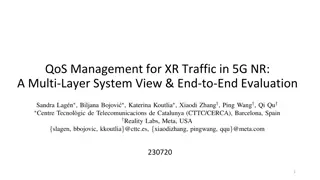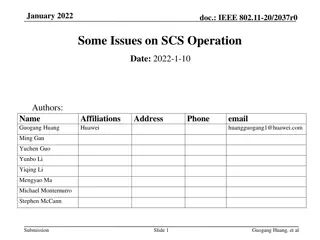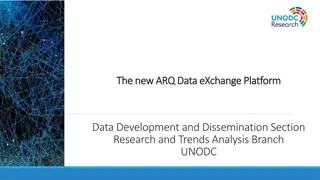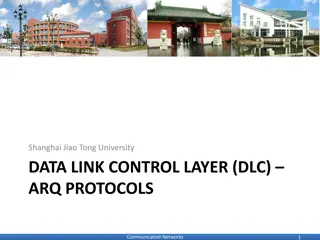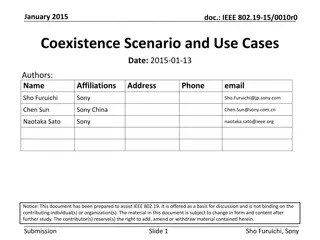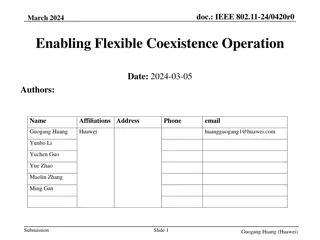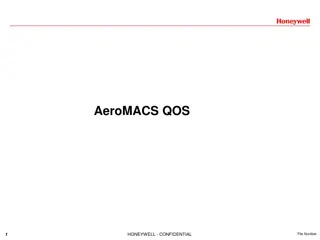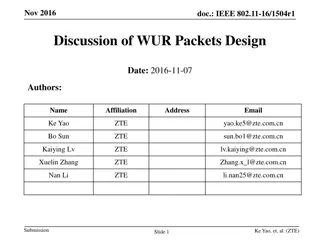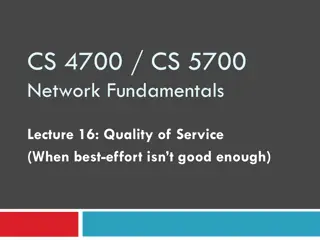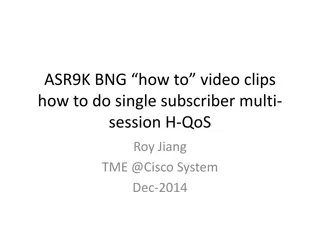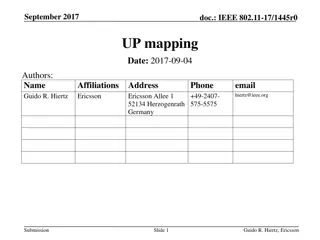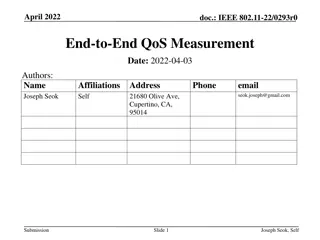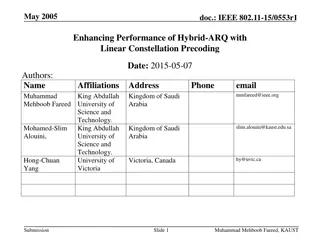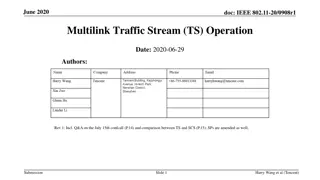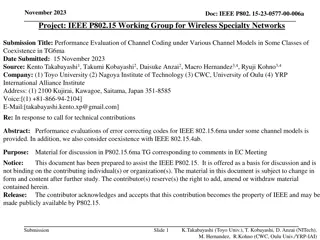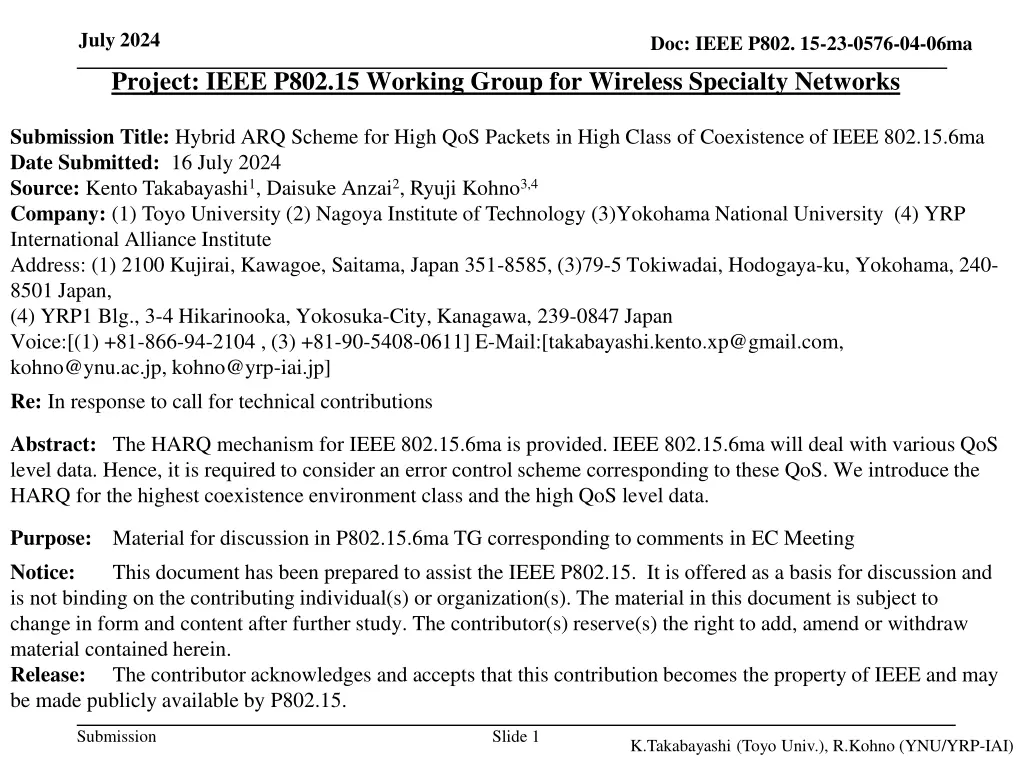
Hybrid ARQ Scheme for High QoS Packets in IEEE 802.15.6ma
Explore the hybrid ARQ mechanism for high QoS packets in IEEE 802.15.6ma, focusing on error control schemes for various QoS levels. Learn about the HARQ for the highest coexistence environment class and high QoS data. Discover the importance of QoS control in WBAN systems and optimal error control for sensor data transmission.
Download Presentation

Please find below an Image/Link to download the presentation.
The content on the website is provided AS IS for your information and personal use only. It may not be sold, licensed, or shared on other websites without obtaining consent from the author. If you encounter any issues during the download, it is possible that the publisher has removed the file from their server.
You are allowed to download the files provided on this website for personal or commercial use, subject to the condition that they are used lawfully. All files are the property of their respective owners.
The content on the website is provided AS IS for your information and personal use only. It may not be sold, licensed, or shared on other websites without obtaining consent from the author.
E N D
Presentation Transcript
July 2024 Doc: IEEE P802. 15-23-0576-04-06ma Project: IEEE P802.15 Working Group for Wireless Specialty Networks Submission Title: Hybrid ARQ Scheme for High QoS Packets in High Class of Coexistence of IEEE 802.15.6ma Date Submitted: 16 July 2024 Source: Kento Takabayashi1, Daisuke Anzai2, Ryuji Kohno3,4 Company: (1) Toyo University (2) Nagoya Institute of Technology (3)Yokohama National University (4) YRP International Alliance Institute Address: (1) 2100 Kujirai, Kawagoe, Saitama, Japan 351-8585, (3)79-5 Tokiwadai, Hodogaya-ku, Yokohama, 240- 8501 Japan, (4) YRP1 Blg., 3-4 Hikarinooka, Yokosuka-City, Kanagawa, 239-0847 Japan Voice:[(1) +81-866-94-2104 , (3) +81-90-5408-0611] E-Mail:[takabayashi.kento.xp@gmail.com, kohno@ynu.ac.jp, kohno@yrp-iai.jp] Re: In response to call for technical contributions Abstract: The HARQ mechanism for IEEE 802.15.6ma is provided. IEEE 802.15.6ma will deal with various QoS level data. Hence, it is required to consider an error control scheme corresponding to these QoS. We introduce the HARQ for the highest coexistence environment class and the high QoS level data. Purpose: Notice: is not binding on the contributing individual(s) or organization(s). The material in this document is subject to change in form and content after further study. The contributor(s) reserve(s) the right to add, amend or withdraw material contained herein. Release: The contributor acknowledges and accepts that this contribution becomes the property of IEEE and may be made publicly available by P802.15. Material for discussion in P802.15.6ma TG corresponding to comments in EC Meeting This document has been prepared to assist the IEEE P802.15. It is offered as a basis for discussion and Submission Slide 1 K.Takabayashi (Toyo Univ.), R.Kohno (YNU/YRP-IAI)
Doc: IEEE P802. 15-23-0576-04-06ma July 2024 Hybrid ARQ Scheme for High QoS Packets in High Class of Coexistence of IEEE 802.15.6ma July 2024, Hybrid Session, Sheraton Le Centre Montreal, Montreal, Quebec, Canada Kento Takabayashi(1), Daisuke Anzai(2), Ryuji Kohno(3,4) (1) Toyo University (2) Nagoya Institute of Technology (3)Yokohama National University (4) YRP International Alliance Institute Submission Slide 2 K.Takabayashi (Toyo Univ.), R.Kohno (YNU/YRP-IAI)
Doc: IEEE P802. 15-23-0576-04-06ma July 2024 Importance of QoS control In WBAN systems, a wearable vital sign sensor node can include various types of sensors with different data rates, the allowable communication error ratio and delay User priority Traffic designation Frame type 0 Background (BK) Data 1 Best effort (BE) Data 2 Excellent effort (EE) Data IEEE 802.15.6 based WBAN may deal with 8 levels of user priority data 3 Video (VI) Data 4 Voice (VO) Data 5 Medical data or network control Data or management Those data have a wide range of quality of service (QoS) 6 High-priority medical data or network control Data or management 7 Emergency or medical implant event report Data Therefore, optimal error control for input data is an important feature in sensor data transmission procedures Submission Slide 3 K.Takabayashi (Toyo Univ.), R.Kohno (YNU/YRP-IAI)
Doc: IEEE P802. 15-23-0576-04-06ma July 2024 Coexistence environment level Coexistence environment class 0 1 [1a] 2 [1b] 3 4 [2a] 5 [2b] 6 [2c] Environment 6ma BAN only Multiple 6ma BANs 1a Multiple 15.6 & 6ma BANs Multiple 6ma BANs & non-UWB systems (Wi-Fi & Unlicensed 3GPP) Multiple 6ma BANs & 802.15 UWB systems Multiple 6ma BANs, non-802.15 UWB systems (ETSI UWB systems) Multiple 6ma BANs & 802.15 UWB & non-802.15 UWB systems (ETSI UWB) Multiple 6ma BANs & non-UWB systems (Wi-Fi & Unlicensed 3GPP) & 802.15 UWB & non-802.15 UWB systems (ETSI UWB) 7 A hybrid ARQ (HARQ) shall be utilized at the highest class 7 15.6ma considers the half-rate BCC and LDPC as an error correcting code A HARQ scheme using those FEC is introduced Submission Slide 4 K.Takabayashi (Toyo Univ.), R.Kohno (YNU/YRP-IAI)
Doc: IEEE P802. 15-23-0576-04-06ma July 2024 Hybrid ARQ mechanism (BCC case) 1. Firstly, the information bit sequence ? is encoded by BCC (K=7, R=1/2) 2. An encoded codeword is punctured via the punctured matrices as shown in the previous slide, and codeword 1 and 1 are generated Submission Slide 5 K.Takabayashi (Toyo Univ.), R.Kohno (YNU/YRP-IAI)
Doc: IEEE P802. 15-23-0576-04-06ma July 2024 Hybrid ARQ mechanism (BCC case) 3. The codeword 1 is transmitted to a receiver 4. If bit errors are detected after decoding the codeword 1, a receiver buffers the transmitted codeword 1, and a transmitter re-sends the codeword 1 to a receiver 5. At the receiver, transmitted codeword 1 is combined with a buffered codeword 1, and a reconstructed codeword 1 (R=1/2) is generated Submission Slide 6 K.Takabayashi (Toyo Univ.), R.Kohno (YNU/YRP-IAI)
Doc: IEEE P802. 15-23-0576-04-06ma July 2024 Hybrid ARQ mechanism (BCC case) 6. If bit errors are detected after decoding the reconstructed codeword , a receiver buffers the reconstructed codeword 1, and a transmitter re-sends the codeword 1 to a receiver 7. At the receiver, transmitted codeword 1 is combined with the buffered reconstructed codeword 1, and a reconstructed codeword 2 (R 1/3) is generated 8. After that, codeword 1 and 1 are transmitted alternately, and the receiver reconstructs and decodes low-rate error correcting codes Submission Slide 7 K.Takabayashi (Toyo Univ.), R.Kohno (YNU/YRP-IAI)
Doc: IEEE P802. 15-23-0576-04-06ma July 2024 Hybrid ARQ mechanism (BCC case) ?: Counter of the number of transmissions, initially ? = 0 ?: The maximum number of transmissions, user defined ??: Coding rate at the ?th transmission ?1decreases as follows: 8/9 1/2 1/3 1/4 1/5 The punctured matrices are as follows: Codeword 1 1 0 0 1 1 0 0 1 1 0 0 1 1 1 0 1 Codeword 1 1 1 1 0 0 1 1 0 0 1 1 0 0 1 1 0 Submission Slide 8 K.Takabayashi (Toyo Univ.), R.Kohno (YNU/YRP-IAI)
Doc: IEEE P802. 15-23-0576-04-06ma July 2024 Concept of Hybrid ARQ mechanism Advantages of the hybrid ARQ mechanism 1. The coding rate is very wide Bit errors are sufficiently eliminated at the high coding rate under very good channel conditions Very low coding rates remove bit errors under bad channel conditions A coding rate at the first transmission may be changed according to channel conditions 2. In the case of the small number of retransmissions, it is sufficient to transmit the small number of redundant bits This characteristic leads to improvement of energy efficiency and reduction of transmission delay at retransmission Submission Slide 9 K.Takabayashi (Toyo Univ.), R.Kohno (YNU/YRP-IAI)
Doc: IEEE P802. 15-23-0576-04-06ma July 2024 Hybrid ARQ mechanism (LDPC case) ?: Counter of the number of transmissions, initially ? = 0 ?: The maximum number of transmissions, user defined In LDPC case, the mechanism is the same as the HARQ defined in 15.6 Std.-2012 Submission Slide 10 K.Takabayashi (Toyo Univ.), R.Kohno (YNU/YRP-IAI)
Doc: IEEE P802. 15-23-0576-04-06ma July 2024 Bit erasure channel 0 1 1 0 0 1 0 0 1 0 1 1 1 0 1 1 0 0 0 1 1 Consecutive bit erasures Bit erasure channel is assumed, which simulate asynchronous interference from other systems It is assumed that consecutive bit erasures of up to ??% of the length of PSDU ?????occur ??is uniformly distributed in the interval [0 ??] Submission Slide 11 K.Takabayashi (Toyo Univ.), R.Kohno (YNU/YRP-IAI)
Doc: IEEE P802. 15-23-0576-04-06ma July 2024 Evaluation Channel model AWGN, Bit erasure Bandwidth (BW) 499.2 MHz Center Frequency 3993.6 MHz Modulation BPSK Error detection code CRC-16-CCITT Inner FEC IEEE802.15.4ab BCC, LDPC (R=1/2) Outer FEC (54,46), (54,38), (54,28), (54,14) shortened Reed- Solomon (sRS) Codes Decoding algorism SOVA (BCC, SOCC), Belief propagation (LDPC) PSDU length (?????) Maximum erasure ratio (??) Maximum number of retransmissions (????) ARQ scheme 1296 bits 10% 0, 1, 4 (LDPC), 0, 1, 3 (BCC) Stop and wait Those simulations applied those FEC and a simple ARQ, not the proposed HARQ Submission Slide 12 K.Takabayashi (Toyo Univ.), R.Kohno (YNU/YRP-IAI)
Doc: IEEE P802. 15-23-0576-04-06ma July 2024 Results Packet error ratio in the case of LDPC and ARQ, ????= 0,4,8 Submission Slide 13 K.Takabayashi (Toyo Univ.), R.Kohno (YNU/YRP-IAI)
Doc: IEEE P802. 15-23-0576-04-06ma July 2024 Results Packet error ratio in the case of BCC and ARQ (not proposed HARQ) ????= 0,3,6,9 Submission Slide 14 K.Takabayashi (Toyo Univ.), R.Kohno (YNU/YRP-IAI)
Doc: IEEE P802. 15-23-0576-04-06ma July 2024 Results Packet error ratio in the case of LDPC and HARQ, ????= 0,1,4 Submission Slide 15 K.Takabayashi (Toyo Univ.), R.Kohno (YNU/YRP-IAI)
Doc: IEEE P802. 15-23-0576-04-06ma July 2024 Results Packet error ratio in the case of BCC and HARQ, ????= 0,1,3 Submission Slide 16 K.Takabayashi (Toyo Univ.), R.Kohno (YNU/YRP-IAI)
Doc: IEEE P802. 15-23-0576-04-06ma July 2024 Summary In the case of LDPC with ARQ and HARQ, PER improved as ???? increased, and no error floor occurred In the case of BCC and ARQ, PER also improved as ????increased, however error floor occurred depending on the coding rate of RS codes and whether RS codes is applied Especially it is difficult for the only BCC and simple ARQ case to deal with continuous bit erasures by retransmission alone The next step is to evaluate the performance of the proposed HARQ in the same environment to confirm its effectiveness Submission Slide 17 K.Takabayashi (Toyo Univ.), R.Kohno (YNU/YRP-IAI)
July 2024 Doc: IEEE P802. 15-23-0576-04-06ma Thank you for your attention ! ! ! Submission Slide 18 K.Takabayashi (Toyo Univ.), R.Kohno (YNU/YRP-IAI)

